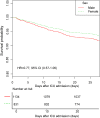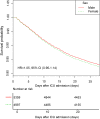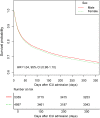Sex Differences in Short- and Long-Term Survival Among Critically Ill Patients with Sepsis
- PMID: 33658834
- PMCID: PMC7920582
- DOI: 10.2147/IJGM.S294229
Sex Differences in Short- and Long-Term Survival Among Critically Ill Patients with Sepsis
Abstract
Background: Currently, there have been studies showing a correlation between sex differences and prognosis. Nevertheless, the conclusions of clinical studies on sex-based differences are controversial. We aimed to evaluate the effect of sex on the short- and long-term survival of critically ill patients with sepsis.
Methods: We use the critical care database of the healthcare information mart. Cox models were conducted to determine the relationship of 28-day and 1-year mortality with a different sex. Interaction and stratified analyses were conducted to test whether the effect of sex differed across age and sequential organ failure assessment (SOFA) score subgroups.
Results: A total of 12,321 patients were enrolled in this study. The Cox regression analysis showed that the 28-day and 1-year mortality rates of female patients were significantly lower than those of male patients by 10% and 8%, respectively (hazard ratio [HR]=0.90, 95% confidence interval [CI] 0.83-0.98, and HR=0.92, 95% CI 0.87-0.97, respectively). The effects of the association between sex and 28-day and 1-year mortality were broadly consistent for age and the SOFA subgroup variables. Only age was observed to have significant interactions in the 1-year mortality (P=0.0177). Compared with male patients, female patients aged <50 years had a long-term survival advantage (HR=0.77, 95% CI 0.62-0.95). In contrast, we did not find sex-based differences in the short- and long-term survival for patients aged ≥50 years.
Conclusion: In the current retrospective large database review, the 28-day and 1-year mortality were significantly lower in females than in male patients among critically ill patients with sepsis. Notably, there was an interaction between age and sex, and whether female-associated hormones or other contributing factors affect the clinical outcomes of patients with sepsis needs to be further researched.
Keywords: critical care; prognosis; sepsis; sex.
© 2021 Lin et al.
Conflict of interest statement
The authors have no conflicts of interest to declare.
Figures






Similar articles
-
[Effects of circadian heart rate variation on short-term and long-term mortality in intensive care unit patients: a retrospective cohort study based on MIMIC-II database].Zhonghua Wei Zhong Bing Ji Jiu Yi Xue. 2019 Sep;31(9):1128-1132. doi: 10.3760/cma.j.issn.2095-4352.2019.09.014. Zhonghua Wei Zhong Bing Ji Jiu Yi Xue. 2019. PMID: 31657338 Chinese.
-
Association between comorbid diabetes mellitus and prognosis of patients with sepsis in the intensive care unit: a retrospective cohort study.Ann Transl Med. 2021 Jan;9(1):22. doi: 10.21037/atm-20-4360. Ann Transl Med. 2021. PMID: 33553315 Free PMC article.
-
[The prognostic value of serum procalcitonin on severity of illness in non-sepsis critically ill patients].Zhonghua Wei Zhong Bing Ji Jiu Yi Xue. 2016 Aug;28(8):688-93. doi: 10.3760/cma.j.issn.2095-4352.2016.08.004. Zhonghua Wei Zhong Bing Ji Jiu Yi Xue. 2016. PMID: 27434557 Chinese.
-
[Association between early central venous pressure measurement and mortality in patients with sepsis: a data analysis of MIMIC-III database].Zhonghua Wei Zhong Bing Ji Jiu Yi Xue. 2021 Jul;33(7):786-791. doi: 10.3760/cma.j.cn121430-20201120-00722. Zhonghua Wei Zhong Bing Ji Jiu Yi Xue. 2021. PMID: 34412745 Chinese.
-
[Monocyte/lymphocyte ratio as a predictor of 30-day mortality and adverse events in critically ill patients: analysis of the MIMIC-III database].Zhonghua Wei Zhong Bing Ji Jiu Yi Xue. 2021 May;33(5):582-586. doi: 10.3760/cma.j.cn121430-20201223-00772. Zhonghua Wei Zhong Bing Ji Jiu Yi Xue. 2021. PMID: 34112297 Chinese.
Cited by
-
Sex differences in long-term survival after intensive care unit treatment for sepsis: A cohort study.PLoS One. 2023 Feb 24;18(2):e0281939. doi: 10.1371/journal.pone.0281939. eCollection 2023. PLoS One. 2023. PMID: 36827250 Free PMC article.
-
Sex differences in clinical presentation and mortality in emergency department patients with sepsis.Ann Med. 2023;55(2):2244873. doi: 10.1080/07853890.2023.2244873. Ann Med. 2023. PMID: 37566727 Free PMC article.
-
The Impact of Biological Sex And High-Fat High-Fructose Diet on Brain Dysfunction in an Animal Model of Sepsis.Mol Neurobiol. 2025 Sep;62(9):11196-11209. doi: 10.1007/s12035-025-04937-y. Epub 2025 Apr 23. Mol Neurobiol. 2025. PMID: 40268828
References
LinkOut - more resources
Full Text Sources
Other Literature Sources

